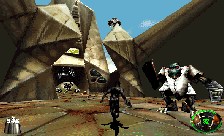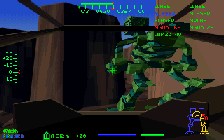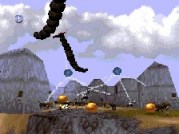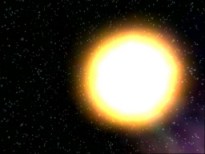3D
HARDWARE
 The
Playstation (or PSX) and Saturn were remarkable machines for their time,
able to copy nearly any arcade machine you could mention. This meant, that
for Sega the way forward was obvious. Cutting edge, Sega arcade games,
like Virtua Racing, Daytona, Virtua Fighter etc. were all ported from arcade
to Saturn. This made the Saturn into a moderately successful machine. However,
the PSX was already on everyone's 'must buy' list, so even though the Saturn
was launched first, the PSX won the battle hands down. Maybe it was the
look of the PSX, or maybe it was just that the PSX promised better games.
Technically, the Saturn was the more powerful machine. It had 2 x 27.5MHz
main processsors running in parallel and 4MB of RAM, while the PSX had
a single 33MHz CPU and 2MB of RAM. So in theory the Saturn was the better
console and was certainly better at raw number crunching. The PSX though
had more support from software developers and became the more popular machine,
despite it's later release. If you owned a PC at this time, you might remember
games like Wipeout, Virtua Fighter and Daytona coming out on these systems
looking so sharp and fast that the PC's games paled in comparison. When
converted to the PC, games like Wipeout looked pretty rough. Although this
is in part due to the fact that a PC uses a high-res display monitor and
the PSX is hooked up to a blurry TV set, there's no denying that the PC's
graphics were much more broken looking than the PSX's.
The
Playstation (or PSX) and Saturn were remarkable machines for their time,
able to copy nearly any arcade machine you could mention. This meant, that
for Sega the way forward was obvious. Cutting edge, Sega arcade games,
like Virtua Racing, Daytona, Virtua Fighter etc. were all ported from arcade
to Saturn. This made the Saturn into a moderately successful machine. However,
the PSX was already on everyone's 'must buy' list, so even though the Saturn
was launched first, the PSX won the battle hands down. Maybe it was the
look of the PSX, or maybe it was just that the PSX promised better games.
Technically, the Saturn was the more powerful machine. It had 2 x 27.5MHz
main processsors running in parallel and 4MB of RAM, while the PSX had
a single 33MHz CPU and 2MB of RAM. So in theory the Saturn was the better
console and was certainly better at raw number crunching. The PSX though
had more support from software developers and became the more popular machine,
despite it's later release. If you owned a PC at this time, you might remember
games like Wipeout, Virtua Fighter and Daytona coming out on these systems
looking so sharp and fast that the PC's games paled in comparison. When
converted to the PC, games like Wipeout looked pretty rough. Although this
is in part due to the fact that a PC uses a high-res display monitor and
the PSX is hooked up to a blurry TV set, there's no denying that the PC's
graphics were much more broken looking than the PSX's.
 What
made these machines, so much more powerful than the PC's of the time, many
of which may have had 4 times the ram and twice the processor? The answer,
quite simply was the additional 3D hardware present in these games machines.
Even when the Pentium reached 100MHz, it was no match for the fluidity
of the games consoles. Obviously, if the multimedia PC was to become a
viable games platform something was needed to boost the 3D performance.
Something similar to what the PSX and Saturn had. Something to eliminate
the burden that a 3D engine places on a processor.
What
made these machines, so much more powerful than the PC's of the time, many
of which may have had 4 times the ram and twice the processor? The answer,
quite simply was the additional 3D hardware present in these games machines.
Even when the Pentium reached 100MHz, it was no match for the fluidity
of the games consoles. Obviously, if the multimedia PC was to become a
viable games platform something was needed to boost the 3D performance.
Something similar to what the PSX and Saturn had. Something to eliminate
the burden that a 3D engine places on a processor.
For
a little while nothing happened. Then, fairly suddenly, both Diamond and
Creative Labs launched new products. They were a new concept called 3D
cards. The Diamond effort was called the Diamond Edge and was based on
an integrated sound/video/3D solution from NVidia. Designed for the new
PCI BUS and hence only for Pentium systems, the Diamond Edge didn't really
boost 3D performance that much. In reality a software engine could do the
same job if it was written well enough. Creative Labs card the 3D Blaster was for 486's, designed for the VESA Local BUS slot. It was based on the
3D Labs GLINT processor and was an add-on card rather than a video card,
much like the 3dfx Voodoo line of cards. It's fair to say that this card
offered a significant boost in performance to specially modified games.
The games bundled included NASCAR Racing, Hi-Octane, Magic Carpet Rebel
Moon and ran as well on a 486 DX4-100MHz with a 3D Blaster as the normal
edition of the game would run on a Pentium 166MHz! Quite an achievement
really. It's usefulness was limited by the fact that you couldn't use it
in Pentium systems though, and within a few months it was practically forgotten.
was for 486's, designed for the VESA Local BUS slot. It was based on the
3D Labs GLINT processor and was an add-on card rather than a video card,
much like the 3dfx Voodoo line of cards. It's fair to say that this card
offered a significant boost in performance to specially modified games.
The games bundled included NASCAR Racing, Hi-Octane, Magic Carpet Rebel
Moon and ran as well on a 486 DX4-100MHz with a 3D Blaster as the normal
edition of the game would run on a Pentium 166MHz! Quite an achievement
really. It's usefulness was limited by the fact that you couldn't use it
in Pentium systems though, and within a few months it was practically forgotten.
Everyone
was moving onto the Pentium chip now and the Pentium motherboards (bar
a very few exceptions) all had PCI and ISA slots only. Since there had
only been a couple of failed attempts at marketing a 3D card, the arena
was still clear for anyone else who wished to take up the challenge. Pretty
soon, when the Pentium was more common, companies like NEC and 3dfx released
their new cards to the world. Both were a vast improvement on the cards
seen up to then, but, NEC made their card so that it would get faster,
the faster your machine. The design therefore required a high end Pentium
and around 24MB of RAM to work at full speed. They also didn't implement
bi-linear filtering in the first edition of the card which left textures
looking decidedly messy. Nobody really had a system of this class at the
time of the cards launch anyway.
 3dfx
on the other hand designed their Voodoo chipset to work on lower-end Pentium's
and it did have bi-linear filtering support which made games look infinitely
better. Support from the industry was almost immediate. Games came out
at a phenomenal rate and PC owners after a few months began to buy the
various Voodoo cards at a rate to match. The PC was at last capable of
rendering hundreds of thousands of texture-mapped polygons and had various
tricks to makes the image look sharp, clean and to make the game run smoothly.
At the very least a PC equipped with a 3dfx card could draw even with a
PSX and more powerful CPU's coupled with this card could make a PSX look
dated.
3dfx
on the other hand designed their Voodoo chipset to work on lower-end Pentium's
and it did have bi-linear filtering support which made games look infinitely
better. Support from the industry was almost immediate. Games came out
at a phenomenal rate and PC owners after a few months began to buy the
various Voodoo cards at a rate to match. The PC was at last capable of
rendering hundreds of thousands of texture-mapped polygons and had various
tricks to makes the image look sharp, clean and to make the game run smoothly.
At the very least a PC equipped with a 3dfx card could draw even with a
PSX and more powerful CPU's coupled with this card could make a PSX look
dated.
Soon
after, Intel released some new extensions to their CPU's called MMX. Available
on Pentium 166MHz upwards, MMX CPU's had in-built additions to their
instruction set, designed to boost 3D, video and sound performance by up
to 400%! Of course things never work out the way they are intended, but,
MMX although little used, did move the PC up yet another level in performance
and helped to win over more home users, making the PC more of a consumer
item.
 3D
cards and 3D technology in general has continued to develop since then.
In mid '98, AMD released their 3DNow extensions to MMX which were more
specific in targetting 3D rather than multimedia. Quake 2 with 3DNow drivers
achieved a staggering 80% increase in speed! However, the same cannot be
said for other games and drivers. More recently, Intel launched their answer
to 3DNow, the SSE extensions. Also designed to enhance the 3D capabilities
of the PC, no games have as yet implemented them, though plenty are on
the way. The AGP BUS is yet another recent innovation that allows more
data to be shifted between graphics card and CPU. We are now in the 3rd
generation of 3D accelerators and recent cards are around 15 times more
powerful than the 1st generation Voodoo. No doubt 3D cards will continue
to advance until you can't discern between reality and computer generated
3D. Many industry leaders predict that in a few years, current games will
be regarded in the same way as we regard Space Invaders now. I can't wait!
3D
cards and 3D technology in general has continued to develop since then.
In mid '98, AMD released their 3DNow extensions to MMX which were more
specific in targetting 3D rather than multimedia. Quake 2 with 3DNow drivers
achieved a staggering 80% increase in speed! However, the same cannot be
said for other games and drivers. More recently, Intel launched their answer
to 3DNow, the SSE extensions. Also designed to enhance the 3D capabilities
of the PC, no games have as yet implemented them, though plenty are on
the way. The AGP BUS is yet another recent innovation that allows more
data to be shifted between graphics card and CPU. We are now in the 3rd
generation of 3D accelerators and recent cards are around 15 times more
powerful than the 1st generation Voodoo. No doubt 3D cards will continue
to advance until you can't discern between reality and computer generated
3D. Many industry leaders predict that in a few years, current games will
be regarded in the same way as we regard Space Invaders now. I can't wait!
 The
Playstation (or PSX) and Saturn were remarkable machines for their time,
able to copy nearly any arcade machine you could mention. This meant, that
for Sega the way forward was obvious. Cutting edge, Sega arcade games,
like Virtua Racing, Daytona, Virtua Fighter etc. were all ported from arcade
to Saturn. This made the Saturn into a moderately successful machine. However,
the PSX was already on everyone's 'must buy' list, so even though the Saturn
was launched first, the PSX won the battle hands down. Maybe it was the
look of the PSX, or maybe it was just that the PSX promised better games.
Technically, the Saturn was the more powerful machine. It had 2 x 27.5MHz
main processsors running in parallel and 4MB of RAM, while the PSX had
a single 33MHz CPU and 2MB of RAM. So in theory the Saturn was the better
console and was certainly better at raw number crunching. The PSX though
had more support from software developers and became the more popular machine,
despite it's later release. If you owned a PC at this time, you might remember
games like Wipeout, Virtua Fighter and Daytona coming out on these systems
looking so sharp and fast that the PC's games paled in comparison. When
converted to the PC, games like Wipeout looked pretty rough. Although this
is in part due to the fact that a PC uses a high-res display monitor and
the PSX is hooked up to a blurry TV set, there's no denying that the PC's
graphics were much more broken looking than the PSX's.
The
Playstation (or PSX) and Saturn were remarkable machines for their time,
able to copy nearly any arcade machine you could mention. This meant, that
for Sega the way forward was obvious. Cutting edge, Sega arcade games,
like Virtua Racing, Daytona, Virtua Fighter etc. were all ported from arcade
to Saturn. This made the Saturn into a moderately successful machine. However,
the PSX was already on everyone's 'must buy' list, so even though the Saturn
was launched first, the PSX won the battle hands down. Maybe it was the
look of the PSX, or maybe it was just that the PSX promised better games.
Technically, the Saturn was the more powerful machine. It had 2 x 27.5MHz
main processsors running in parallel and 4MB of RAM, while the PSX had
a single 33MHz CPU and 2MB of RAM. So in theory the Saturn was the better
console and was certainly better at raw number crunching. The PSX though
had more support from software developers and became the more popular machine,
despite it's later release. If you owned a PC at this time, you might remember
games like Wipeout, Virtua Fighter and Daytona coming out on these systems
looking so sharp and fast that the PC's games paled in comparison. When
converted to the PC, games like Wipeout looked pretty rough. Although this
is in part due to the fact that a PC uses a high-res display monitor and
the PSX is hooked up to a blurry TV set, there's no denying that the PC's
graphics were much more broken looking than the PSX's.
 What
made these machines, so much more powerful than the PC's of the time, many
of which may have had 4 times the ram and twice the processor? The answer,
quite simply was the additional 3D hardware present in these games machines.
Even when the Pentium reached 100MHz, it was no match for the fluidity
of the games consoles. Obviously, if the multimedia PC was to become a
viable games platform something was needed to boost the 3D performance.
Something similar to what the PSX and Saturn had. Something to eliminate
the burden that a 3D engine places on a processor.
What
made these machines, so much more powerful than the PC's of the time, many
of which may have had 4 times the ram and twice the processor? The answer,
quite simply was the additional 3D hardware present in these games machines.
Even when the Pentium reached 100MHz, it was no match for the fluidity
of the games consoles. Obviously, if the multimedia PC was to become a
viable games platform something was needed to boost the 3D performance.
Something similar to what the PSX and Saturn had. Something to eliminate
the burden that a 3D engine places on a processor.
 was for 486's, designed for the VESA Local BUS slot. It was based on the
3D Labs GLINT processor and was an add-on card rather than a video card,
much like the 3dfx Voodoo line of cards. It's fair to say that this card
offered a significant boost in performance to specially modified games.
The games bundled included NASCAR Racing, Hi-Octane, Magic Carpet Rebel
Moon and ran as well on a 486 DX4-100MHz with a 3D Blaster as the normal
edition of the game would run on a Pentium 166MHz! Quite an achievement
really. It's usefulness was limited by the fact that you couldn't use it
in Pentium systems though, and within a few months it was practically forgotten.
was for 486's, designed for the VESA Local BUS slot. It was based on the
3D Labs GLINT processor and was an add-on card rather than a video card,
much like the 3dfx Voodoo line of cards. It's fair to say that this card
offered a significant boost in performance to specially modified games.
The games bundled included NASCAR Racing, Hi-Octane, Magic Carpet Rebel
Moon and ran as well on a 486 DX4-100MHz with a 3D Blaster as the normal
edition of the game would run on a Pentium 166MHz! Quite an achievement
really. It's usefulness was limited by the fact that you couldn't use it
in Pentium systems though, and within a few months it was practically forgotten.
 3dfx
on the other hand designed their Voodoo chipset to work on lower-end Pentium's
and it did have bi-linear filtering support which made games look infinitely
better. Support from the industry was almost immediate. Games came out
at a phenomenal rate and PC owners after a few months began to buy the
various Voodoo cards at a rate to match. The PC was at last capable of
rendering hundreds of thousands of texture-mapped polygons and had various
tricks to makes the image look sharp, clean and to make the game run smoothly.
At the very least a PC equipped with a 3dfx card could draw even with a
PSX and more powerful CPU's coupled with this card could make a PSX look
dated.
3dfx
on the other hand designed their Voodoo chipset to work on lower-end Pentium's
and it did have bi-linear filtering support which made games look infinitely
better. Support from the industry was almost immediate. Games came out
at a phenomenal rate and PC owners after a few months began to buy the
various Voodoo cards at a rate to match. The PC was at last capable of
rendering hundreds of thousands of texture-mapped polygons and had various
tricks to makes the image look sharp, clean and to make the game run smoothly.
At the very least a PC equipped with a 3dfx card could draw even with a
PSX and more powerful CPU's coupled with this card could make a PSX look
dated.
 3D
cards and 3D technology in general has continued to develop since then.
In mid '98, AMD released their 3DNow extensions to MMX which were more
specific in targetting 3D rather than multimedia. Quake 2 with 3DNow drivers
achieved a staggering 80% increase in speed! However, the same cannot be
said for other games and drivers. More recently, Intel launched their answer
to 3DNow, the SSE extensions. Also designed to enhance the 3D capabilities
of the PC, no games have as yet implemented them, though plenty are on
the way. The AGP BUS is yet another recent innovation that allows more
data to be shifted between graphics card and CPU. We are now in the 3rd
generation of 3D accelerators and recent cards are around 15 times more
powerful than the 1st generation Voodoo. No doubt 3D cards will continue
to advance until you can't discern between reality and computer generated
3D. Many industry leaders predict that in a few years, current games will
be regarded in the same way as we regard Space Invaders now. I can't wait!
3D
cards and 3D technology in general has continued to develop since then.
In mid '98, AMD released their 3DNow extensions to MMX which were more
specific in targetting 3D rather than multimedia. Quake 2 with 3DNow drivers
achieved a staggering 80% increase in speed! However, the same cannot be
said for other games and drivers. More recently, Intel launched their answer
to 3DNow, the SSE extensions. Also designed to enhance the 3D capabilities
of the PC, no games have as yet implemented them, though plenty are on
the way. The AGP BUS is yet another recent innovation that allows more
data to be shifted between graphics card and CPU. We are now in the 3rd
generation of 3D accelerators and recent cards are around 15 times more
powerful than the 1st generation Voodoo. No doubt 3D cards will continue
to advance until you can't discern between reality and computer generated
3D. Many industry leaders predict that in a few years, current games will
be regarded in the same way as we regard Space Invaders now. I can't wait!